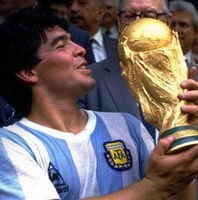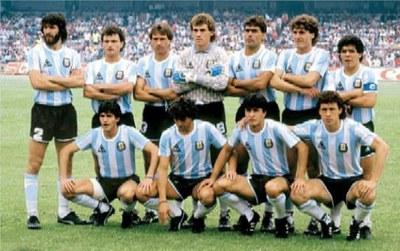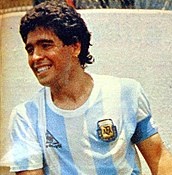Buenos Aires (Argentina), 1960
Por Equipe Latino americana
 Diego Armando Maradona was born on October 30, 1960, in Villa Fiorito, a poor neighborhood on the outskirts of Buenos Aires, Argentina. He began playing soccer at the age of nine with a youth team, Los Cebollitas, with which he maintained an undefeated streak of 136 matches. At fifteen, he signed his first contract with the club Argentinos Juniors and debuted in the first division in 1976, ten days before turning 16. Despite his young age, he was close to participating in the 1978 Argentina World Cup, but coach Luis César Menotti decided not to call him up. He shone, however, in the 1979 Youth World Cup in Japan, where he was the captain of the champion team and won the award for best player of the tournament. After 166 matches and 111 goals for Argentinos Juniors, he was bought in 1980 by Boca Juniors, the most popular team in Buenos Aires. He wore the blue and yellow Boca jersey for the first time in 1981 against Talleres, scoring two goals – his bond with the fans was immediate. “¡Lo quería Barcelona / lo quería River Plate / Maradona es de Boca / porque gallina no es!” sang the Boca fans proudly, teasing their River Plate rivals. Despite this, money spoke louder and, in the summer of 1982, the number 10, just one year after his debut, left for Barcelona, Spain. El pibe de oro would only return to play for Boca in 1995, for one final season.
Diego Armando Maradona was born on October 30, 1960, in Villa Fiorito, a poor neighborhood on the outskirts of Buenos Aires, Argentina. He began playing soccer at the age of nine with a youth team, Los Cebollitas, with which he maintained an undefeated streak of 136 matches. At fifteen, he signed his first contract with the club Argentinos Juniors and debuted in the first division in 1976, ten days before turning 16. Despite his young age, he was close to participating in the 1978 Argentina World Cup, but coach Luis César Menotti decided not to call him up. He shone, however, in the 1979 Youth World Cup in Japan, where he was the captain of the champion team and won the award for best player of the tournament. After 166 matches and 111 goals for Argentinos Juniors, he was bought in 1980 by Boca Juniors, the most popular team in Buenos Aires. He wore the blue and yellow Boca jersey for the first time in 1981 against Talleres, scoring two goals – his bond with the fans was immediate. “¡Lo quería Barcelona / lo quería River Plate / Maradona es de Boca / porque gallina no es!” sang the Boca fans proudly, teasing their River Plate rivals. Despite this, money spoke louder and, in the summer of 1982, the number 10, just one year after his debut, left for Barcelona, Spain. El pibe de oro would only return to play for Boca in 1995, for one final season.

After a disappointing performance at the 1982 World Cup in Spain – his first World Cup appearance ended on a sour note with a red card in a loss to Brazil – Maradona debuted for the Catalan team in September. Three months, thirteen matches, and a few beautiful goals later, hepatitis forced him into complete rest for three months. He only returned to the pitch in February 1983, finding Barcelona with a new coach: the same Menotti who had cut him from the 1978 World Cup squad was now his ally at Barcelona. A win in the Copa del Rey seemed to suggest things would improve for Maradona, but in September of that same year, a severe ankle fracture sidelined him once again. Just over a hundred days later, the Argentine star returned to the field, but at the end of the season, in May 1984, he left Spain for Italy, still without having fully proven his immense talent.
It was only when Maradona arrived in Naples that he discovered his team had avoided relegation the previous season by just one point. After playing for one of the richest teams in the world, his start at Napoli resembled his early days with Argentinos Juniors. He also experienced firsthand the discrimination of playing in the south of the country – in his first match in Verona, in the north, the home fans’ banners read “Lavatevi!” (wash yourselves). In the 1984/85 season, Napoli had a poor start but was not at risk of relegation. In 1985/86, they finished third, marking the beginning of a shift in the geopolitics of Italian football.
World Cup Glory
In 1986, Maradona was the captain and main player of Argentina. The World Cup, originally to be held in Colombia, ended up taking place in Mexico, and Latin American teams were the favorites (at the time, European teams had never won a World Cup held outside their own continent). In the quarter-finals, Argentina faced England, four years after the Falklands War, and the rivalry went beyond football. In this match, Maradona scored two of the most famous goals in World Cup history. The first was with his hand, rising above English goalkeeper Peter Shilton – later, the Argentine forward would say, when asked how he scored the goal: “it was with Maradona’s head and the hand of God.” Four minutes later, El Diez scored what many consider the most beautiful goal in World Cup history. Starting from his own half, he dribbled past six English players, including the goalkeeper, before scoring. After that, Argentina celebrated a victory over Belgium in the semi-finals and a 3–1 win over Germany in the final. Maradona was the undisputed best player in the world.
Back in Napoli, he gave the fans what they had waited sixty years for: their first scudetto (Italian league title), in the 1986/87 season. After that, Napoli finished among the top teams in the league, won the UEFA Cup in 1990, and another scudetto in 1989/90 (with a team that also featured Brazilian player Careca). The San Paolo stadium in Naples became the center of the footballing world. Fans would chant: “o mamma mamma mamma, sai perché mi batte il corazon? Ho visto Maradona, ho visto Maradona, eh, mammà, innamorato son.”
The 1990 World Cup was held in Italy, and Maradona would be playing, in a way, at home. With difficulty, Argentina advanced past the group stage and defeated Brazil (with a goal by Caniggia assisted by Maradona) in the round of 16. After defeating Yugoslavia in a penalty shootout, the semi-final was against Italy. The Italy vs. Argentina match at the San Paolo highlighted a range of tensions, not just involving Maradona. It exposed the racism of the country where the Argentine had become a peerless idol, as well as the conflict between Naples (and southern Italy) and the rest of the nation. Maradona, who played much of the tournament injured in his ankle and foot, immediately appealed to Napoli fans to support him against Italy:
[…] I regret that now they ask Neapolitans to be Italian and support the national team. Naples has always been marginalized by the rest of Italy […] the North despises them, doesn’t consider them part of Italy. Will they support those who see them as foreigners in their own country or support me, who is one of you?Despite the star’s pleas, the banners read: “Maradona: Naples loves you, but Italy is our homeland.” And so, while most of the more than 70,000 fans booed the Argentine anthem, TV cameras caught El Pibe cursing at the crowd. Again on penalties, after a 1–1 draw, Argentina won. Playing with injections, Maradona led his team to the final but lost 1–0 to Germany and finished as runner-up, weeping uncontrollably as he received the medal.
Back in Naples after that Italy vs. Argentina match, things could never be the same. He did not finish his seventh season with the blue and white team: in March 1991, in a match against Sampdoria, he tested positive for traces of cocaine in a doping test and was suspended from football for fifteen months. Soon after, in Buenos Aires, he was arrested for drug possession. When the suspension ended, he asked to be transferred and left Naples – where he remains an object of adoration and reverence.
He moved to Sevilla, in Spain: less than a year, 29 matches, eight goals, some great moments, and a conflict with coach Carlos Bilardo. In September 1993, he returned to Argentina to play for Newell’s Old Boys, in Rosario, where he played just five matches. He returned to the Argentine national team to help qualify for the World Cup in the United States.
The 1994 World Cup in the United States was his fourth, and at 33 years old, he underwent an intense physical recovery program. In the first match, Argentina beat Greece 2–0 with a great goal from El Diego. However, in the second match, against Nigeria, Maradona was selected for doping control and tested positive for a banned substance: ephedrine. FIFA suspended him from the World Cup. Diego would later say: “they cut off my legs.”
In October 1995, he returned to Boca, where he played until 1997. During that time, he abandoned his earlier critical stance and supported the candidacy of President Carlos Menem. Five days before his 37th birthday, he retired from football for good. In 2000, he had a heart attack and checked into a rehab clinic in Cuba, supported by his friend Fidel Castro, where he decided to write his autobiography titled Yo soy el Diego. That same year, he was voted the best football player of the century in a poll conducted by FIFA. In November 2001, Maradona played in a tribute match alongside other greats, in a Bombonera stadium filled with his devoted fans.
In April 2004, the Argentine star was admitted to the ICU of the Suizo-Argentina clinic in Buenos Aires. He was 43 years old, weighed over 100 kilograms, and faced severe hypertension and heart problems mainly due to cocaine use. After nearly a month of hospitalization, he left the hospital against the wishes of his family and doctors. In March 2005, he underwent gastric bypass surgery in Cartagena, Colombia. In August, he debuted on Argentina’s Channel 13 with the TV show La noche del Diez, with Pelé as his first guest.
Maradona was the coach of the Argentina national team from 2008 to 2010. Between 2011 and 2012, he coached Al Wasl, a team in the United Arab Emirates. Even away from the pitch, he remained Argentina’s biggest football star – though now rivaled by Lionel Messi. What hadn’t changed was his controversial, contradictory, and critical style. As writer Oswaldo Soriano put it:
In times of minimalism and mediocre men, he seems like a myth, a character from a fairy tale; he has the profile of someone who believes in heroism, bravery, and devotion to a cause.



